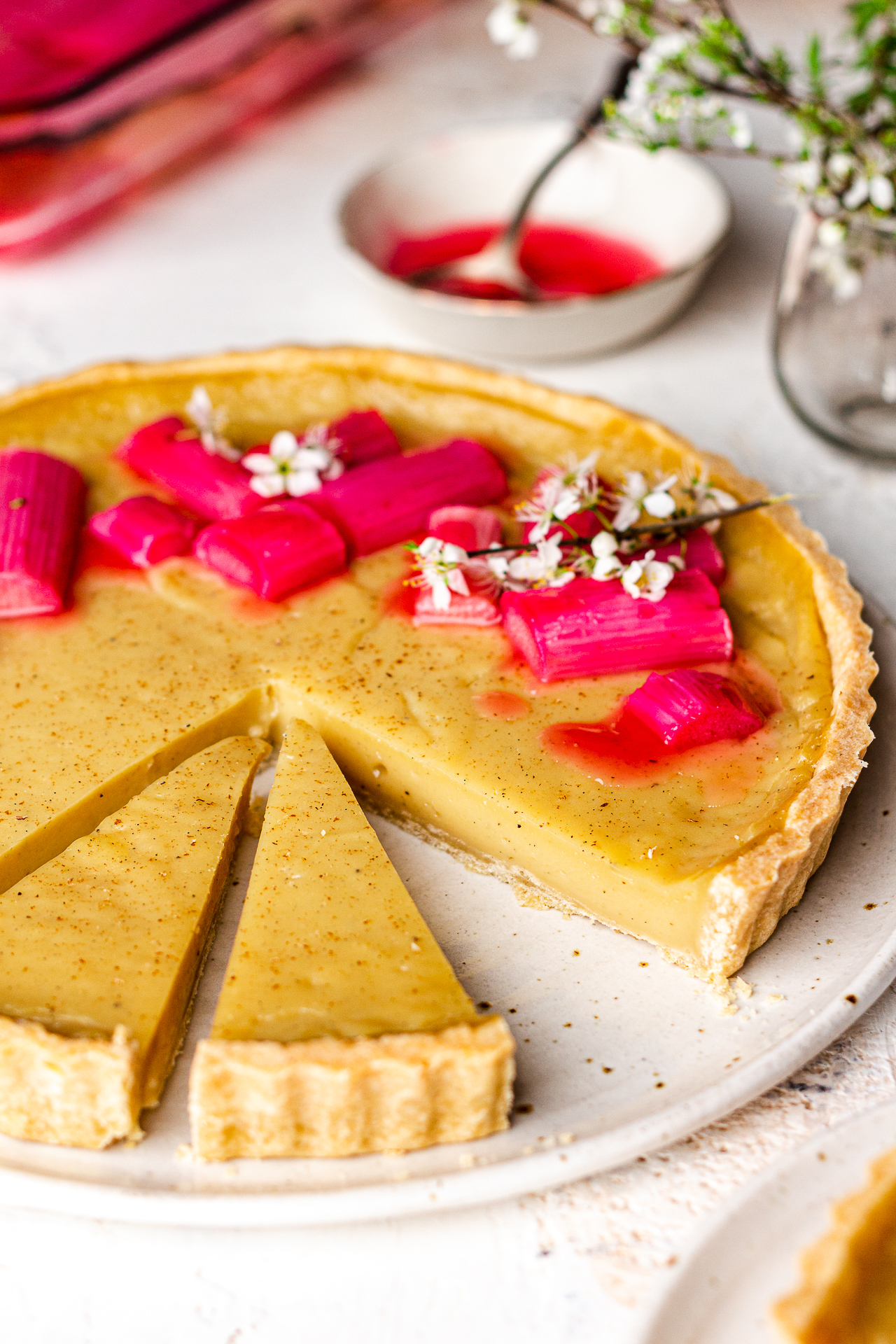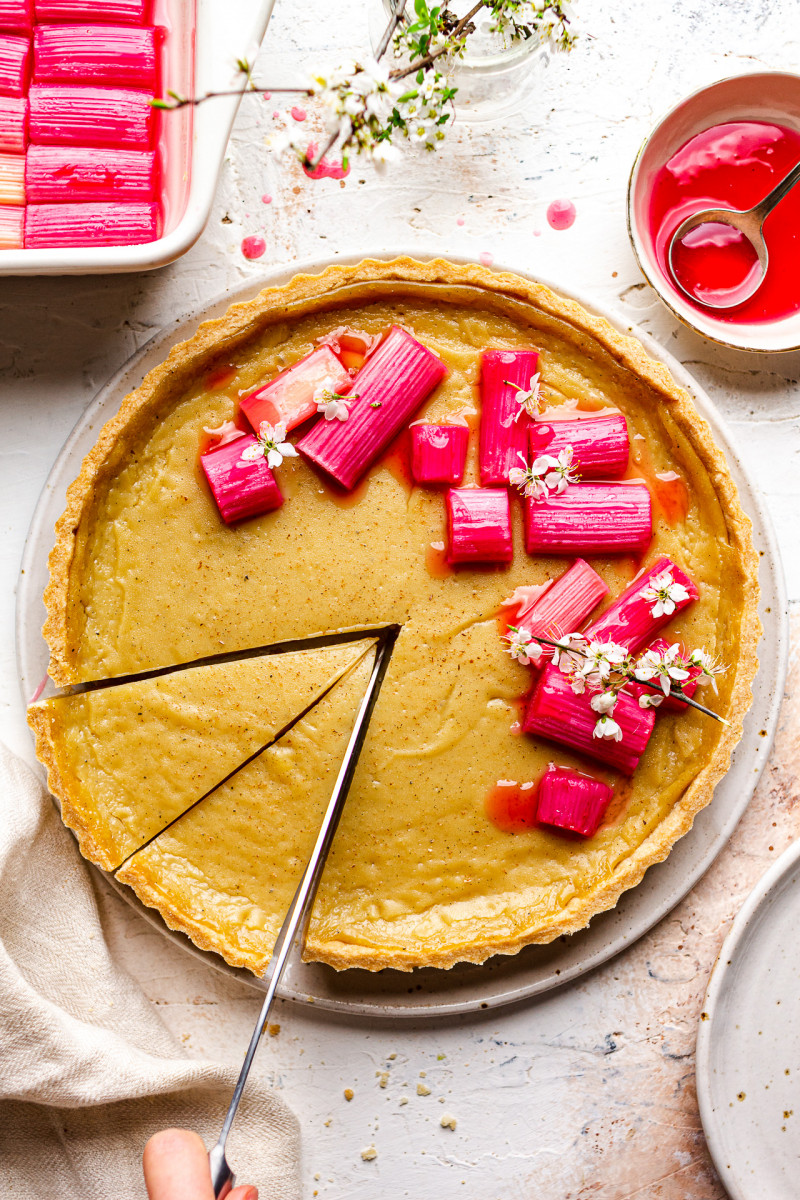
Easter is coming up so I thought a spring inspired dessert would probably be timely. I thought about making an impressive chocolate tart (like this one) or a lemon flavored tart, but I thought what was missing from my blog was a great vegan custard tart so I settled on this one, I hope the recipe works.
This adult-sized vegan custard tart is based on this stand-alone vegan custard tart I made a while back so if a big tart seems like too much and you’re bad with the general theme, you might want to check them out instead.
I combined a dairy-free and eggless version of this classic dessert with my favorite fruit of the season – the obligatory rhubarb, which I roasted in the oven. It’s amazing pink color is simply irresistible and its tangy flavor offsets the sweetness of this tart so beautifully. I understand that pink rhubarb is not available everywhere so you can serve this tart naked with a sprinkling of nutmeg or cinnamon or make it with any tangy fruit or fruit compote of your choice. Raspberries were my second go-to when I couldn’t find rhubarb locally.
More about ingredients
Although it may seem counterintuitive — since this traditional dessert relies heavily on eggs — my vegan version doesn’t require many or any special vegan ingredients. It is all very easy and available in a large supermarket.
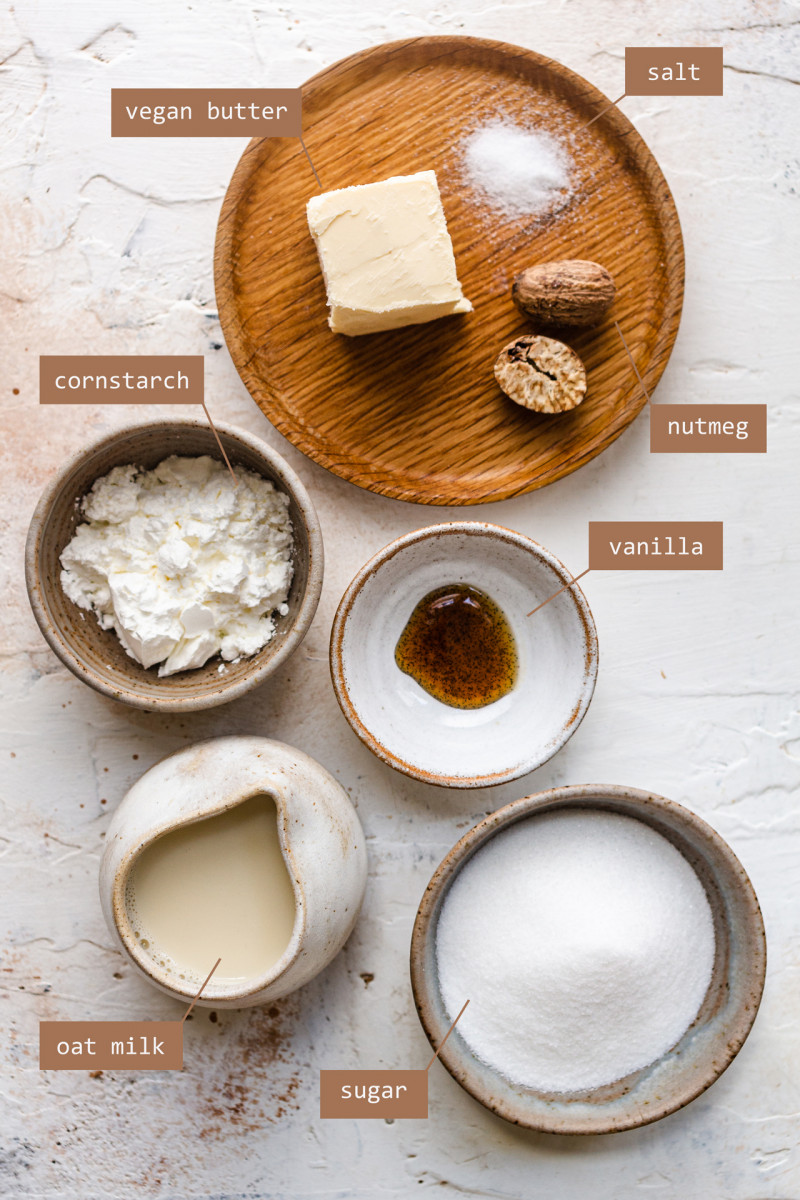
AP Flour: Pastries are made with all-purpose (also known as plain) white flour. If you want to make this gluten-free, use a balanced gluten-free flour mixture and some xanthan gum to hold the pastry together.
Vegan butter: Vegan butter, also known as vegan block, makes the best pastries. I usually use the Danish brand Naturli and the Greek brand called Violife, which is available in most UK supermarkets. Naturli is unsalted so if you use vegan butter rather than salt, you may want to add less salt to the pastry. If vegan butter is out of your reach, use coconut oil instead. My recommendation is to use a refined version like this so that the final product doesn’t taste like coconut and it will be hard when you take the pastry out of the fridge – let it acclimate before trying to roll out.
Barley milk: I used Oatly Barista, a rich oat milk to make the custard filling. Any rich (thick, not watered down) plan milk will give you a rich plant-based custard. I tested this recipe with a higher percentage (8%) of soy milk and it turned out equally delicious. Any rich (ie not watered down) plant milk with a neutral flavor will work well. After oat and soy milk, cashews or almonds would be my recommendation.
Casting Sugar: A small amount of sugar is used to sweeten pastries and a lot to sweeten custards. I used caster sugar, which is super fine white sugar in both cases. If this is unavailable, use icing / confectioner’s sugar in pastry and sugar of your choice in custard, making sure it is completely dissolved before adding the cornstarch.
Cornflour / Cornstarch: Cornflour (known as cornstarch in the US) is used to thicken the custard in place of eggs. Cornstarch is also commonly used in a traditional egg-enriched custard, but here we’re using a little more to compensate for the absence of eggs in this recipe.
Vanilla: Custard and vanilla are an inseparable pair, use the best vanilla you can afford and be generous, the vanilla gives this custard more of its flavor.
Cardamom: I like to flavor my custard with a little cardamom, but that’s completely optional. Use cardamom only if you and your guests like it, and don’t overdo it as a strong spice. I used a third of a teaspoon of fresh allspice – it tastes much better than store-bought ground cardamom. If you decide to use cardamom, you may want to skip the nutmeg or cinnamon dust, unless you like that combination of spices.
Salt: A good pinch of salt provides a great counterpoint to the sweetness of any dessert. I used regular table salt and a pinch of kala nam, commonly known as egg salt because of its high sulfur content that makes it taste like eggs.
Yellow: The tiniest pinch of turmeric is nice to add for a warm, egg custard-like, color, but it’s completely optional.
Nutmeg/Cinnamon: Custard is associated with a variety of spices depending on the culture. Here in the UK, dusting custard tarts with nutmeg is very common, in Portugal a sprinkle of cinnamon is often used. Choose the spices you like or skip them altogether if they don’t appeal. If you decide to use nutmeg, get a whole nutmeg and grate it yourself, it is much more aromatic than ground nutmeg from a store.
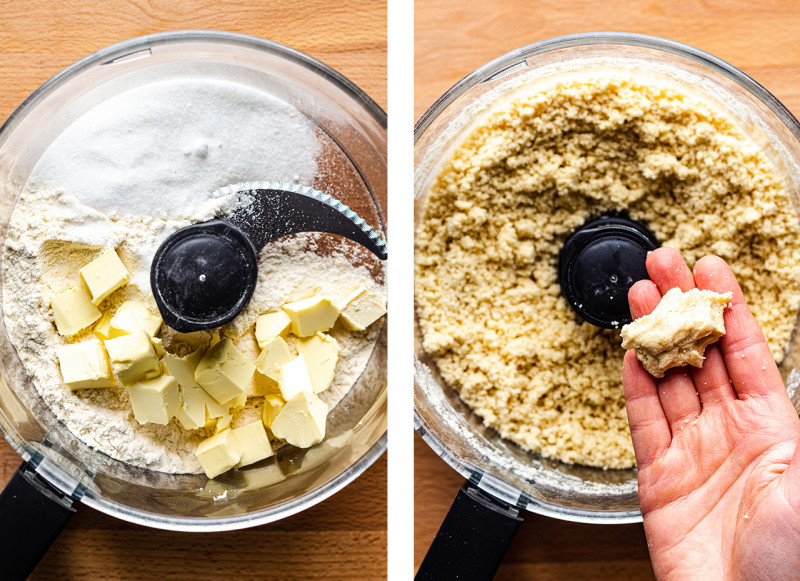
I’ve found that the best way to make the shortening into flour – which is the basis for making shortcrust type pastries – is to use a food processor. Put all your dry ingredients and cubed fat (in this case vegan butter) into a food processor and pulse until the mixture resembles breadcrumbs – small pieces of butter in the flour. Next, start adding cold water very slowly, initially by tablespoonfuls then by teaspoonful increments – you want to add as little as possible. You only want to add enough for the dough to stick together in your hands.
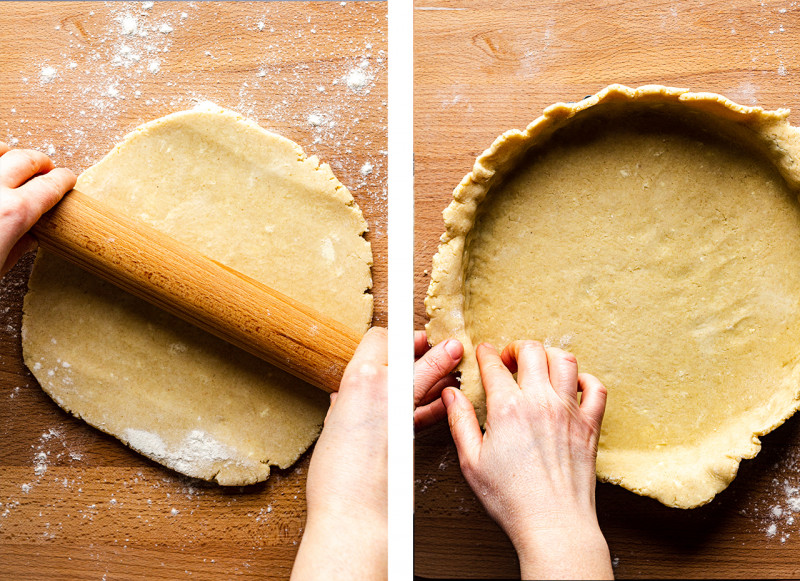
Empty the mixture onto the workbench and gently combine with your hands, press into a disk, cover and rest for at least 30 minutes. After that roll it out so the pastry is not big enough to line the inside of your tart tin and is about 2-3mm thick. Roll it around your rolling pin, place the rolling pin on top of the tart tin, unfold the pastry and gently push it into the tin, making sure it’s loose (not stretched) and reaches the edges.
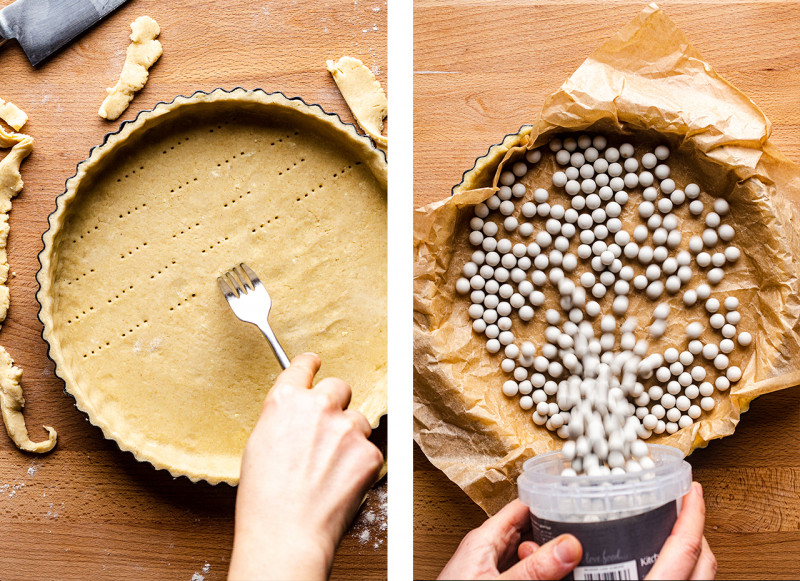
Trim the pastry with a sharp knife, fluff the bottom with a fork and bake blind. Line the pastry with a piece of baking paper and fill with baking beads (or raw beans or rice).
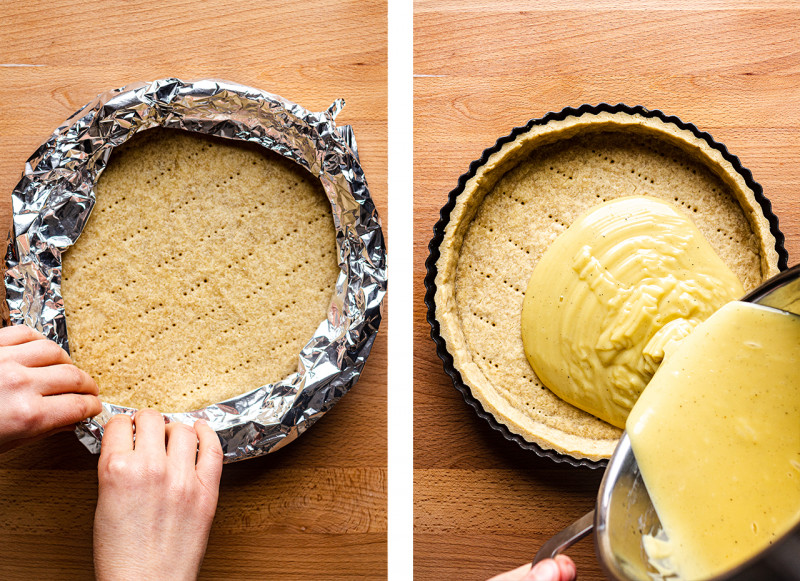
Once you remove the beads, bake it for a few more minutes until the bottom no longer looks raw – you may need to protect the edges with a strip of baking foil so they don’t brown too quickly. When ready fill with custard and bake until set.
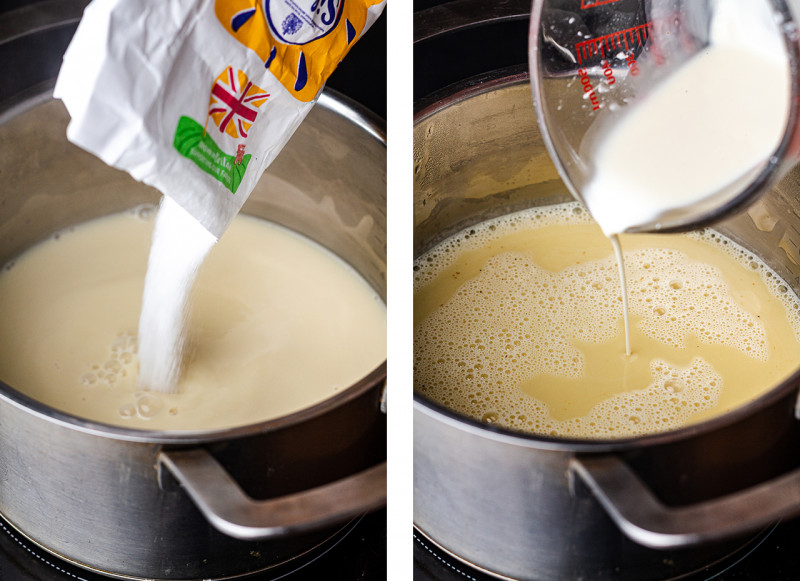
While the pastry is baking, prepare the custard in the oven. Heat plant milk with sugar, thicken with cornstarch slurry, season with vanilla, salt, cardamom (if using) and a pinch of turmeric for color if desired.
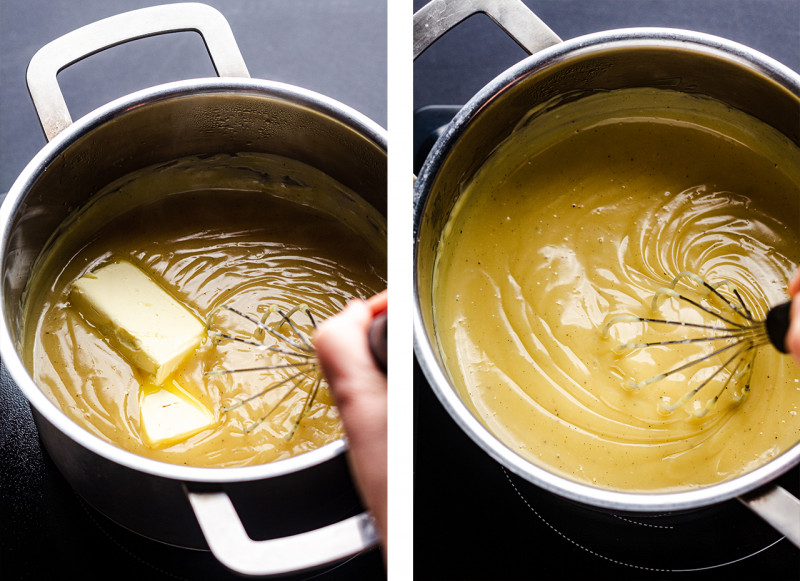
When the custard has thickened, add the vegan butter and let it melt on the residual heat. You should end up with silky smooth, thick but pourable custard. Allow the blind baked pastry to cool slightly before filling the cake and baking again until set.
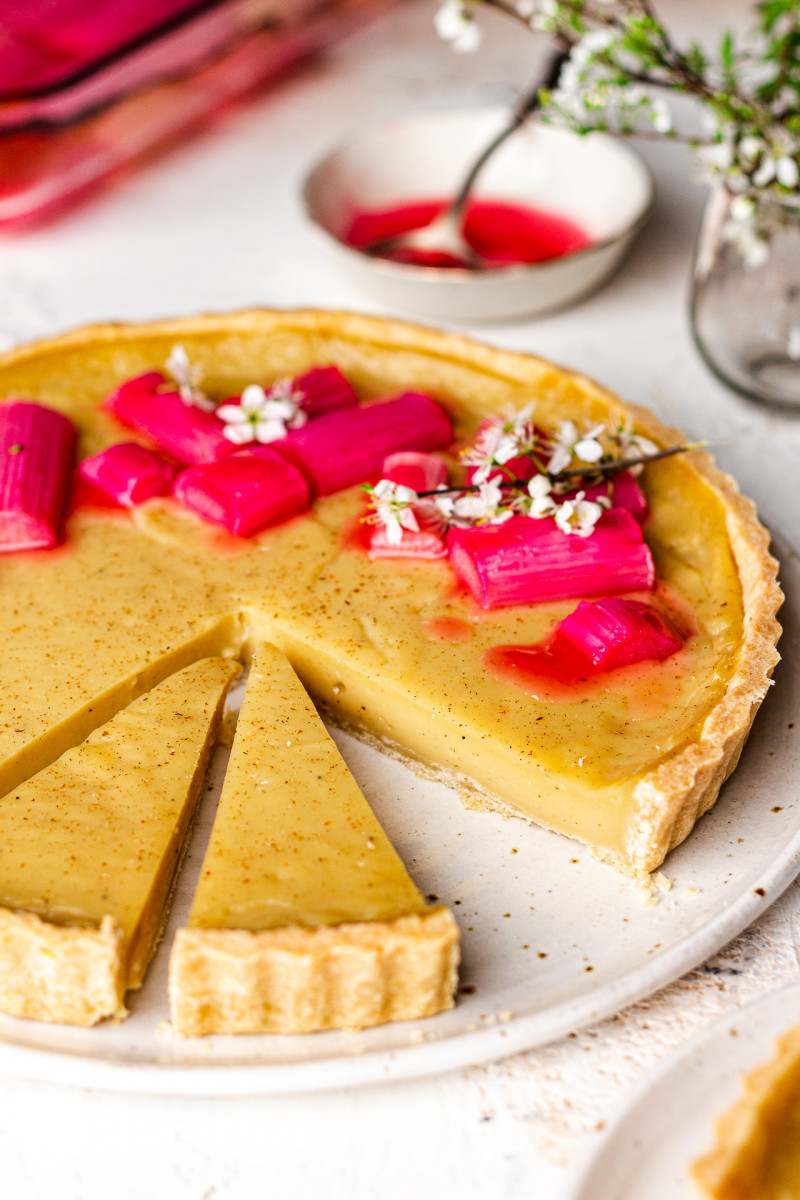
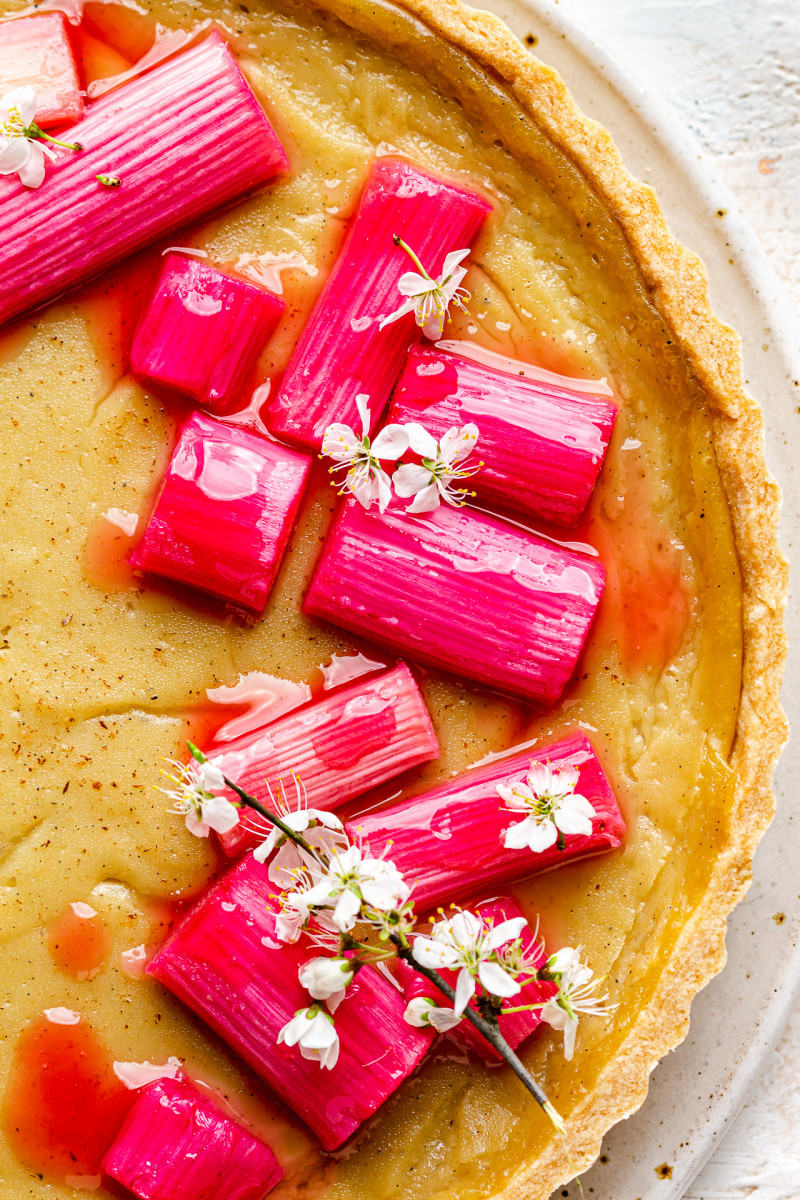
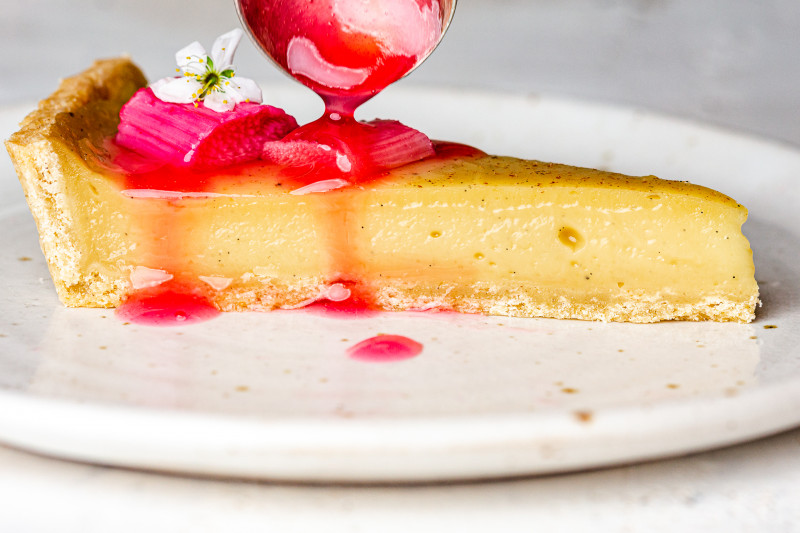

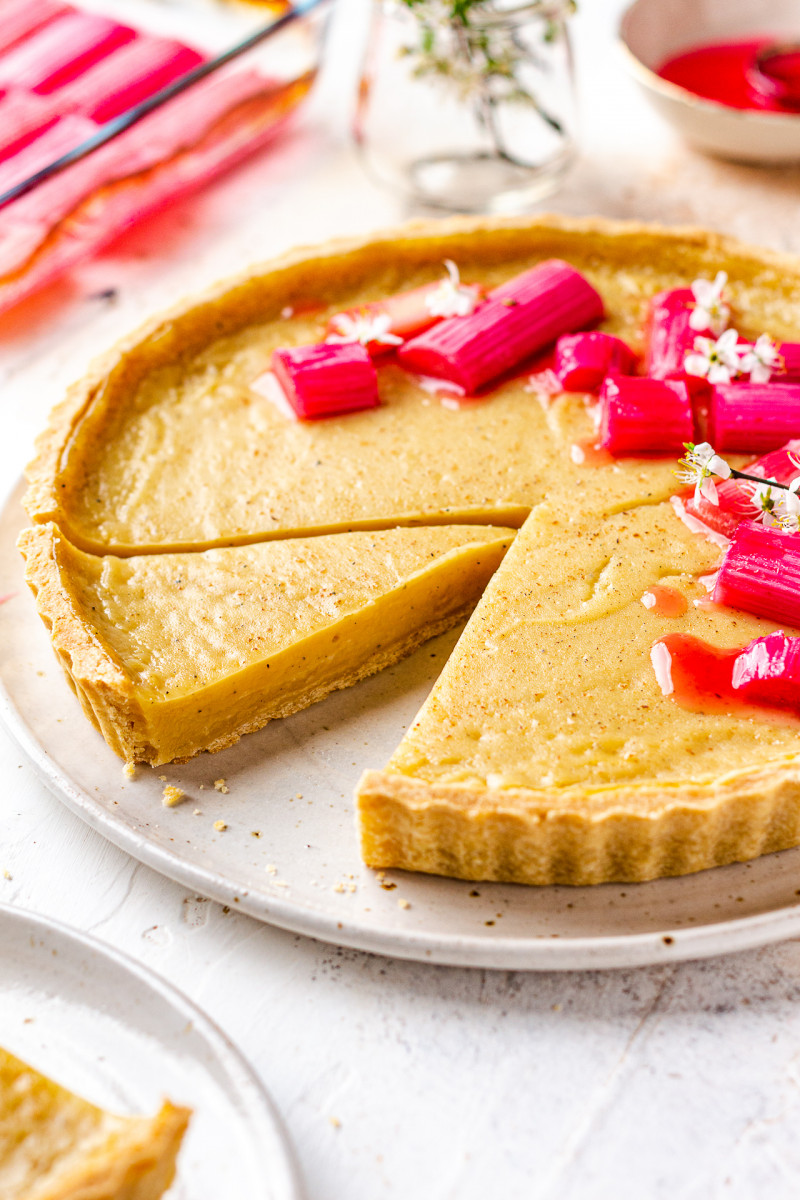
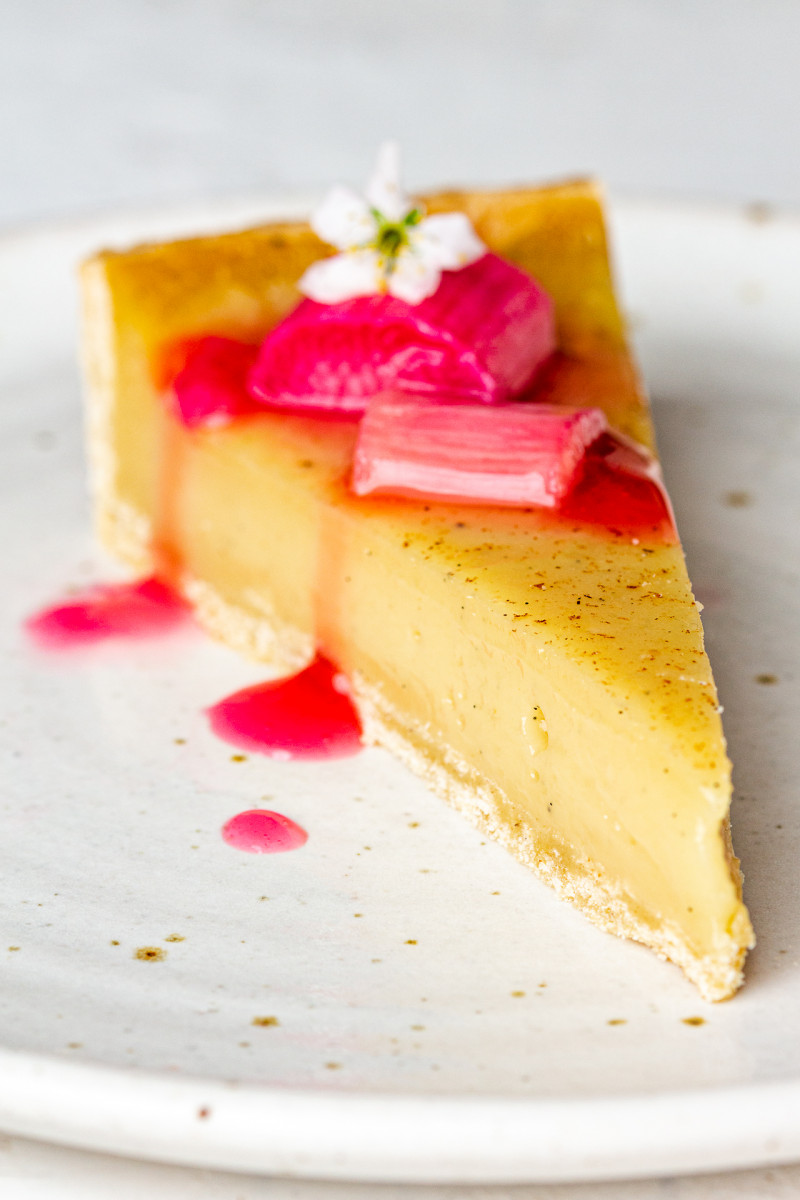
- 210 g / 1¾ cups all-purpose flour or GF plain flour mix
- 25 g / 2 tbsp caster (superfine) sugar
- ½ teaspoon fine salt
- 1½ teaspoons xanthan gum (if using GF flour only)
- 100 g / 3.5 oz vegan butter* (about ½ cup), cubed
- approx. 3 tbsp-4 tbsp ice cold water
Custard filling
- 55 g / scant ½ cup cornflour / cornstarch
- 750 ml / 3 cups + 2 tablespoons creamy plant milk*
- 125 g / ½ cup + 2 tbsp sugar
- 15 ml / 1 tablespoon vanilla extract
- 1/3 teaspoon cardamom*, optional
- 2 pinches of kala namak (egg salt) or regular salt
- 70 g / 2.5 oz (about 1/3 cup) vegan butter
- Sprinkle with nutmeg or cinnamon, optional
Toppings (optional)
- 400 g pink rhubarb
- 35 g / 3 tbsp caster (superfine) sugar
method
pastry
- Place all the pastry ingredients in a food processor – alternatively, you can make the pastry by hand – see photo here.
- Knead in the machine until all the butter has been chopped and coated in the flour – the mixture should resemble fine breadcrumbs.
- Slowly strain the mixture into the ice cold water while whisking. Add water in small, 1 teaspoon amounts towards the end and squeeze with your hands whenever the mixture starts to look like breadcrumbs and clamps – you want to add as little water as possible.
- Empty the food processor onto the workbench. Gently press the dough together with your hands and form it into a disk, but do not knead (otherwise your pastry will be tough).
- Wrap the pastry in cling film and chill in the fridge for 30-60 minutes. 30 minutes before you are ready to take the pastry out, preheat the oven to 180° C / 355° F.
- Remove the dough from the fridge, poke the disc a few times with a rolling pin and then roll it out on a lightly floured surface until the pastry is large enough to line the inside of the tart dish and is about 2-3mm thick. .
- Roll the pastry sheet around your rolling pin and gently place it on top of your baking tin (the non-stick, loose bottom tin I use, otherwise you may want to grease and line your tin). Unroll the pastry and line the inside of the tin with it so that it reaches all the edges.
- Cut off the excess with a sharp knife and use the excess to patch any holes or thin areas. Prick the bottom of the pastry with a fork.
- Line the pastry with a piece of baking paper and fill with baking beads (rice or dried beans).
- Bake for 15 minutes with the baking beads, then remove the paper and beads and bake for a further 5-10 minutes until the bottoms no longer look raw – you may need to protect the edges with a strip of foil if browning too quickly.
Custard filling
- Place cornstarch in a medium bowl, slowly pour in 120 ml / ½ cup oat milk. Stir until the cornstarch is completely dissolved and no lumps remain.
- Measure out the sugar and vegan butter.
- Place the remaining oat milk in a medium-sized pot over low heat.
- Bring the milk to almost a simmer before whisking in the sugar. Cook on low heat until sugar dissolves.
- Trickle in the cornstarch slurry you made in step 1 while whisking the whole time, simmering for a few seconds until the mixture thickens visibly.
- Now whisk in the salt, vanilla, cardamom (if using) and the tiniest pinch of turmeric (just for color). Remove from heat.
- Add the vegan butter to the hot custard and whisk to incorporate. Your vegan custard should be smooth and glossy at this point.
Toppings (optional)
- Trim your rhubarb, cut into more or less uniform – 3cm / 1.25” – slices and arrange in the bottom of a baking tray.
- Add 15 ml / 1 tbsp water and sprinkle evenly with sugar.
- Bake in a 190° C / 375° F oven for about 15-20 minutes, until tender but not falling apart. Cool completely before decorating the tart.
assembly
- Fill the pre-baked pastry case with the custard mixture, smoothing it out with a spatula. Sprinkle with nutmeg (or cinnamon), if using.
- Bake in a 150° C / 300° F oven for about 35 minutes until the edges look set but the center is still wobbly.
- Let cool completely, then refrigerate for at least 2 hours before slicing for a neat look.
- Top with cold roasted rhubarb or other tangy fruit or fruit compote if using.
Comment
*Plant Milk: Any enriched plant milk will work, I’ve tried enriched oat milk (Oatly Barista) and soy milk (8% soy) and both work well, but I prefer the taste of oat milk.
Nutritional information
*1 in every 16 servings

